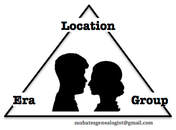What's New
DNA and Genealogy Across DNA Companies Series Click Here and scroll down
Gleaning Clues Series Click Here and scroll down
Beginning Family Historian Series Click Here
Basic Research Skills for the Family Historian
Step by Step directions for research in the big three databases, and online general searches for genealogy research. How do you download to save the documents you found and what are some ways to keep track of your research?
Google Your Way to Genealogy Gems
You won’t know all the hidden genealogy gems until you start googling for genealogy. Learn some tricks of the trade for effective online research including state, county, local, and international websites and databases, including online government sites and more.
Downloading and Uploading
Download sources, books and images to your digital archive. Upload them to your online research tree. Upload your DNA to another company. Downloading and upload between websites and databases can be tricky. Learn some ways to make the smooth transition.
Keeping Track on Paper? in Software? Online?
You do not have to have a subscription or special software to begin your journey into family research. We’ll explore some options and get you started today!
Using Genealogy Newsletters for Research
PERSI and AGBI are two finding aides for location information in History Centers and/or Genealogical Society newsletters. Transcriptions including civil records, family bible pages and tombstones are just some of the sources embedded in these newsletters, a mainstay of genealogy research before computers. How do you access these newsletters?
Do a Double Take for More Research Clues
Vital records, censuses, city directories and more hold overlooked clues about your ancestors. Propel your research into action by doing a double take on records you’ve already hold. There is more to find.
Mind the Gap – Filling Holes in Genealogy Research
We all have gaps in our family research. Suz Bates will share a tried-and-true method using a location timeline for finding holes in your research while simultaneously gleaning hints for the next step in filling those holes.
Family Historian in 3 Basic Steps
Learn three basic steps of being a family historian: finding information, attaching it to your ancestors and storing it so you can find it again. Get organized and get connected as you research your family history.
Creating a Family Archive and Genealogy Library
Q: I have organized many of my papers but have books, photos and documents I need to protect.
R: Learn an easy but effective way to organize your books, photos, and documents? The goal is to have a place for every paper, book and artifact and to be able to find each item when you need it.
Gleaning Clues Series Click Here and scroll down
Beginning Family Historian Series Click Here
Basic Research Skills for the Family Historian
Step by Step directions for research in the big three databases, and online general searches for genealogy research. How do you download to save the documents you found and what are some ways to keep track of your research?
Google Your Way to Genealogy Gems
You won’t know all the hidden genealogy gems until you start googling for genealogy. Learn some tricks of the trade for effective online research including state, county, local, and international websites and databases, including online government sites and more.
Downloading and Uploading
Download sources, books and images to your digital archive. Upload them to your online research tree. Upload your DNA to another company. Downloading and upload between websites and databases can be tricky. Learn some ways to make the smooth transition.
Keeping Track on Paper? in Software? Online?
You do not have to have a subscription or special software to begin your journey into family research. We’ll explore some options and get you started today!
Using Genealogy Newsletters for Research
PERSI and AGBI are two finding aides for location information in History Centers and/or Genealogical Society newsletters. Transcriptions including civil records, family bible pages and tombstones are just some of the sources embedded in these newsletters, a mainstay of genealogy research before computers. How do you access these newsletters?
Do a Double Take for More Research Clues
Vital records, censuses, city directories and more hold overlooked clues about your ancestors. Propel your research into action by doing a double take on records you’ve already hold. There is more to find.
Mind the Gap – Filling Holes in Genealogy Research
We all have gaps in our family research. Suz Bates will share a tried-and-true method using a location timeline for finding holes in your research while simultaneously gleaning hints for the next step in filling those holes.
Family Historian in 3 Basic Steps
Learn three basic steps of being a family historian: finding information, attaching it to your ancestors and storing it so you can find it again. Get organized and get connected as you research your family history.
Creating a Family Archive and Genealogy Library
Q: I have organized many of my papers but have books, photos and documents I need to protect.
R: Learn an easy but effective way to organize your books, photos, and documents? The goal is to have a place for every paper, book and artifact and to be able to find each item when you need it.

